During the cultivation of phalaenopsis, many people find it quite challenging to care for the plants after their flowering period ends. These post-flowering seedlings are not only highly difficult to maintain but also come with numerous potential issues. A deep understanding of the reasons behind this can help us better address the challenges of care and understand the possible adverse effects of post-flowering seedlings.
The difficulty in caring for post-flowering phalaenopsis seedlings first stems from changes in their physiological state. During the flowering period, phalaenopsis consumes a large amount of nutrients to produce beautiful blooms, leaving the plant with severely depleted nutrient reserves and in an extremely weak state. At this time, it needs time to recover, but it is highly sensitive to environmental changes during the recovery process. Slight discomfort in temperature or humidity can affect its normal growth.
For example, excessively high temperatures can easily lead to the proliferation of pathogens, while excessively low temperatures can inhibit the plant's metabolism. Additionally, phalaenopsis are epiphytic plants with aerial roots, and their root systems have strict requirements for water and air. After flowering, the vitality of the roots decreases. If watered excessively, the roots cannot breathe properly and are prone to rot; if watered insufficiently, the roots will dry out due to lack of water, further increasing the difficulty of care.
From the perspective of cultivation management, caring for post-flowering seedlings also presents many challenges. The growing environment in general households often cannot accurately meet their needs. In terms of fertilization, post-flowering seedlings require fertilizers with specific nutrient ratios to replenish nutrients, but many novice gardeners cannot accurately grasp the type, concentration, and frequency of fertilization. Excessive fertilization may cause fertilizer damage and burn the roots, while insufficient fertilization may make it difficult for the plant to resume growth. Moreover, phalaenopsis typically require pruning and repotting after flowering. Improper pruning can affect the germination of new shoots, and root damage during repotting can easily lead to plant death.
In addition to the difficulty of care, post-flowering phalaenopsis seedlings also have some drawbacks. Due to their weak state, they have poor resistance and are prone to pests and diseases. Once infected, not only is it difficult for the post-flowering seedling to survive, but it may also infect surrounding healthy plants, posing a threat to the entire gardening environment.
At the same time, post-flowering seedlings take a long time to resume growth and bloom again. Even with careful care, they may not bloom again within the expected time. For those who pursue ornamental effects and the sense of achievement from gardening, this is undoubtedly a disappointment—investing time and energy without guaranteed returns.
Furthermore, some post-flowering seedlings may have latent growth defects or genetic problems that were masked during the flowering period and gradually emerge after flowering. Continuing to care for such plants not only wastes resources but also occupies gardening space, affecting the introduction and cultivation of new plants.
The difficulty in caring for post-flowering phalaenopsis seedlings stems from the plant's physiological changes and the complexity of cultivation management. Their drawbacks, such as the risk of pests and diseases, uncertain blooming outcomes, and latent growth defects, have deterred many gardeners. By understanding these issues, we can more rationally approach post-flowering phalaenopsis seedlings based on our own circumstances and choose appropriate care strategies or disposal methods.
Why is it difficult to care for phalaenopsis (moth orchid) plants after flowering?

Share with
Tagged in :




Leave a Reply